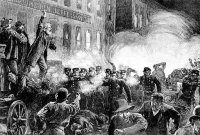
Worksheets and No Prep Teaching Resources
Reading Comprehension Worksheets
 Worksheets and No Prep Teaching Resources Reading Comprehension Worksheets |
|
| edHelper's suggested reading level: | grades 9 to 12 | |
| Flesch-Kincaid grade level: | 8.3 |
|
Fighting For Their Livelihoods - Labor Wars of the 1890s
By Toni Lee Robinson |

|
 1 In the 1890s, the U.S. was forging for itself a new identity. The country was growing into a leading industrial nation. In fact, it was rushing headlong toward a future as a major world power. The course of this race wasn't always smooth. Along the way, several of the runners collided. One of the major clashes was between workers and employers.
1 In the 1890s, the U.S. was forging for itself a new identity. The country was growing into a leading industrial nation. In fact, it was rushing headlong toward a future as a major world power. The course of this race wasn't always smooth. Along the way, several of the runners collided. One of the major clashes was between workers and employers. |
Create Weekly Reading Books
Prepare for an entire week at once! |
| Leave your feedback on Fighting For Their Livelihoods - Labor Wars of the 1890s (use this link if you found an error in the story) |
 |
High School Reading Comprehensions and High School Reading Lessons
|